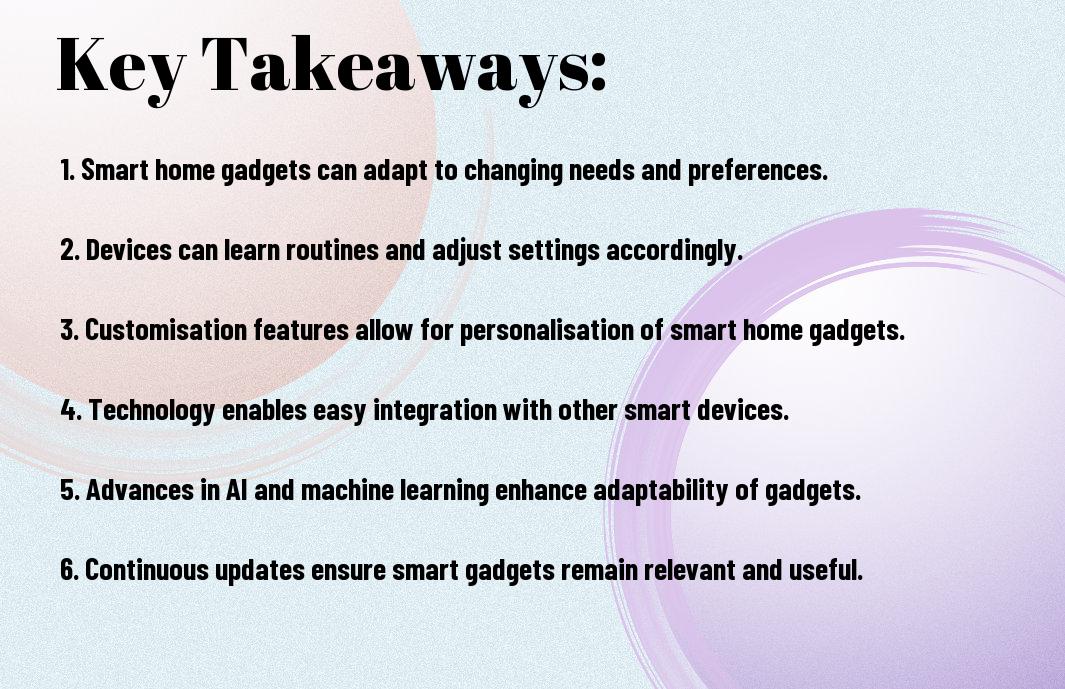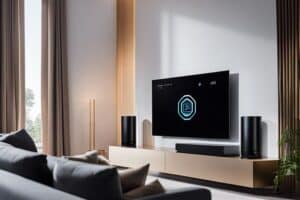Have you ever wondered if smart home gadgets can really keep up with your evolving lifestyle and changing preferences? As technology continues to advance, so do the capabilities of smart home devices. From adjusting to your daily routine to saving energy and enhancing security, these gadgets are designed to make your life easier and more convenient. In this blog post, we will explore the adaptive nature of smart home gadgets and how they can seamlessly integrate into your household’s changing needs and preferences. To learn more about the communication systems in smart home gadgets, visit Technology at Your Convenience Communication Systems ….
Key Takeaways:
- Adaptability: Smart home gadgets have the capability to adapt to a household’s changing needs and preferences by learning and adjusting to the behavioural patterns of the occupants.
- Customisation: Many smart home devices offer customisation options that allow users to tailor the gadgets to their specific preferences, creating a more personalised experience.
- Remote Control: With the ability to be controlled remotely, smart home gadgets can easily be adjusted to accommodate changes in the household’s schedule or activities.
- Integration: Smart home gadgets can be integrated with other devices and systems, allowing them to work together seamlessly to meet the changing needs of a household.
- Continuous Improvement: Manufacturers are constantly updating and improving smart home gadgets, offering new features and capabilities to better serve the evolving preferences of consumers.
Understanding Household Dynamics
When it comes to the functionality of smart home gadgets, it’s crucial to understand the dynamics of your household. Your household is constantly evolving, and so are your needs and preferences. Understanding the intricacies of your household dynamics is essential for smart home gadgets to effectively adapt to your changing requirements.
The Lifecycle of Household Needs
Throughout the lifecycle of your household, your needs and preferences are bound to change. As your family grows, so do your requirements. From baby-proofing your home to creating a versatile space for teenagers, your household needs are constantly evolving. Smart home gadgets need to be adaptable to these changes, providing solutions that cater to different stages of household life.
Identifying Common Changes in Preferences
Changes in preferences are also a common occurrence within households. Your favourite colour might change, or your taste in music might evolve over time. Additionally, household members may develop new interests that influence the functionality of your living space. Understanding these changes in preferences is important for smart home gadgets to ensure they remain relevant and valuable to your household.
The Adaptability of Current Smart Home Technology
Smart home gadgets have evolved to become more adaptable to your household’s changing needs and preferences. This adaptability is made possible through various technological advancements and innovative features that enable these devices to learn and respond to your unique lifestyle.
Software Updates and Learning Algorithms
Software updates are essential for ensuring that your smart home gadgets remain adaptable to your changing needs. Manufacturers frequently release updates to improve the functionality of their devices, fix any bugs, and implement new features. These updates often include learning algorithms that allow the gadgets to analyse your usage patterns and adjust their settings accordingly. This means that over time, your smart home devices can better anticipate your needs and preferences, providing a more personalised and convenient experience for you.
The Role of User Feedback in Gadgets’ Adaptation
Another crucial factor in the adaptability of smart home gadgets is the role of user feedback. Manufacturers often encourage users to provide feedback on their experiences with the devices, whether through dedicated apps, online platforms, or direct communication. Your feedback allows manufacturers to understand your specific requirements and challenges, enabling them to fine-tune their products to better meet your needs. This means that your input directly influences the evolution of smart home technology, ensuring that it continues to adapt to your changing lifestyle.
Challenges and Solutions for Future Smart Homes
As smart home gadgets continue to evolve, they are faced with various challenges that need to be addressed in order to adapt to your household’s changing needs and preferences. In this section, we will explore some of the challenges and possible solutions for future smart homes.
Ensuring Compatibility Across Different Devices and Systems
One of the key challenges in creating a truly smart home is ensuring that all your devices and systems can communicate and work together seamlessly. With the wide variety of smart home gadgets available today, compatibility issues can arise, making it difficult for you to integrate new devices with your existing ones. This can lead to frustration and inefficiency in managing your smart home. To address this challenge, manufacturers and developers are working on creating industry-wide standards and protocols that will ensure interoperability across different devices. This will allow you to mix and match products from different brands without worrying about compatibility issues, ultimately enhancing the comfort and efficiency of your smart home experience. If you want to learn more about how smart home devices can enhance comfort and efficiency, you can check out this article Smart Home Devices: Enhancing Comfort and Efficiency.
Privacy Concerns and Data Security in Adaptive Technologies
Another important challenge for future smart homes is the protection of your privacy and data security. As your smart home gadgets become more adaptive and interconnected, they collect a large amount of sensitive data about you and your daily routines. This raises concerns about how this data is being used and whether it is vulnerable to cyber attacks. It’s crucial for you to be aware of the potential privacy risks and take steps to safeguard your personal information. Manufacturers are developing advanced encryption and security measures to protect your data from unauthorized access, but it’s essential for you to stay vigilant and proactive in managing the security of your smart home devices. By being mindful of your privacy and data security, you can fully enjoy the benefits of a smart home without compromising your personal information.
Case Studies and Real-World Applications
When it comes to smart home gadgets adapting to your household’s changing needs and preferences, there are several case studies and real-world applications that demonstrate their effectiveness. Here are some detailed examples:
- Smart Thermostats: With the ability to learn your habits and preferences, smart thermostats can help you save up to 30% on your energy bills.
- Adaptive Lighting Systems: These systems can adjust the brightness and colour temperature of your lights throughout the day, helping to improve your mood and productivity.
- Voice-Controlled Assistants: Devices like Amazon Alexa and Google Assistant can adapt to your voice and preferences, providing personalised recommendations and information.
Success Stories of Adaptive Smart Home Integration
Many households have experienced significant benefits from the integration of adaptive smart home gadgets. By seamlessly adjusting to your preferences, these devices can enhance your comfort, convenience, and energy efficiency. Imagine coming home to a perfectly lit, temperature-controlled environment tailored to your liking, simply by walking through the door. This level of adaptability not only saves you time and effort but also offers a truly personalised home experience.
Addressing Failures and Lessons Learned
While adaptive smart home gadgets offer numerous benefits, it’s important to address any potential failures or lessons learned from real-world experiences. One common challenge is the initial setup and calibration of these devices, which may require some trial and error to achieve the desired level of adaptability. Additionally, there may be privacy and security concerns associated with the collection and usage of personal data by these gadgets. It’s crucial to stay informed and take necessary precautions to safeguard your privacy while enjoying the benefits of adaptive smart home integration.

Adapting Smart Home Gadgets to Your Changing Needs
Now, with the continuous advancement in technology, smart home gadgets are designed to adapt to your household’s changing needs and preferences. Whether it’s adjusting the lighting to suit your mood, automatically adjusting the thermostat based on your schedule, or even learning your entertainment preferences, these devices are becoming increasingly intuitive and responsive to your lifestyle. By integrating smart home gadgets into your household, you can enjoy the convenience and customisation that comes with technology that adapts to your changing needs and preferences.
FAQ
Q: Can smart home gadgets adapt to a household’s changing needs and preferences?
A: Yes, smart home gadgets are designed to adapt to a household’s changing needs and preferences through advanced technology and programming.
Q: How do smart home gadgets adapt to changing needs?
A: Smart home gadgets can adapt to changing needs through machine learning, sensor technology, and user input. They can also be programmed to adjust based on specific preferences.
Q: What types of smart home gadgets are capable of adapting?
A: Various types of smart home gadgets can adapt to changing needs, including smart thermostats, lighting systems, security cameras, and voice assistants, among others.
Q: Can smart home gadgets learn from user behaviour?
A: Yes, many smart home gadgets have the capability to learn from user behaviour through the analysis of patterns and interactions, allowing them to adjust to preferences over time.
Q: Are there limitations to the adaptability of smart home gadgets?
A: While smart home gadgets are advanced, there may be limitations to their adaptability, such as the range of sensors, the complexity of programming, and the compatibility with other devices in the household.
Q: How can users ensure that smart home gadgets are adapting effectively?
A: Users can ensure that smart home gadgets are adapting effectively by regularly updating software, providing clear preferences and feedback, and monitoring their performance and adjustments.
Q: What are the future possibilities for the adaptability of smart home gadgets?
A: The future holds potential for even greater adaptability in smart home gadgets, including more sophisticated AI, seamless integration with other devices, and personalised, proactive adjustments based on predictive analysis.








